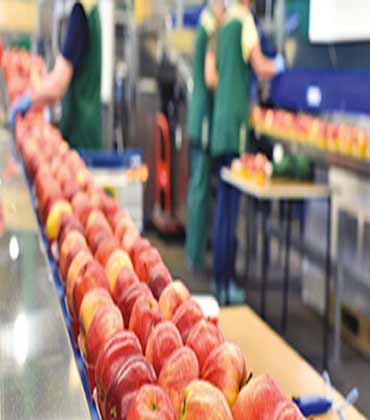THANK YOU FOR SUBSCRIBING
By Todd Jongen, Director Non-Foods Product Development and Packaging Science, US Foods
A Brief History of Carry-Out Food Packaging
By Robert Erhard, Head of Dairy, Corporate Sustainable Agricultural Development, Nestle
Transforming the Food Industry Through a Sustainable...

Food Safety in the News: Fighting the Social Media War
Adeniyi A Odugbemi, PhD, Global Director of Food Safety, ADM

 Adeniyi A Odugbemi, PhD, Global Director of Food Safety, ADM
Adeniyi A Odugbemi, PhD, Global Director of Food Safety, ADMNew regulations, food safety events, technologies, and other happenings continue to shape the way food businesses operate and the impact that food has on the lives of consumers. Furthermore, the diffusion of online fake news about food and food safety is becoming increasingly fast-paced and widespread, making it more difficult for the public to recognize reliable information and deploying negative media trends. We need a collective voice in the food industry to engage with followers on social media to provide information about food safety and answer pertinent questions that follow. This builds trust and ultimately promotes safe food handling and practices.This also help to ensure that only credible information is provided to consumers.
Misinformation about food processing and handling practices harms consumption patterns and creates anxiety among consumers. Fake news and rumors have a particularly negative impact and have affected the purchasing and consumption patterns of consumers. For example, consumers often stop buying certain products or foods due to false rumors spreading on social media, which negatively impacts food businesses and restaurants and decreases economic value. Food security risks also abound; when social media proposes that certain foods are safer than other conventionally grown foods, consumers may have a false sense of security when consuming certain types of food without precautions to prevent contamination. Thus, a necessary tool to protect food safety, food security, and food sustainability within the social media space has become imperative.
Fifty-nine percent of the world's population uses social media; according to Pew Research Center, 7 in 10 American adults scroll on Facebook repeatedly throughout their day. Unfortunately, unverified and baseless information is increasingly being disseminated and accessed through social media applications, and our quickly globalizing world results in headlines being spread across multiple regions. Despite better connections and a more informed public, no one is on the same page on how to fact check erroneous information. There is no uniform standard for content moderation, and there is also no uniform takedown mechanism or tolerance level for false postings. Therefore, food industry experts have urged authorities on the need to monitor inaccurate reports and put out clarifications as soon as possible to show that food safety and quality parameters are non-negotiable. Food and beverage operators (FBOs) as corporate entities must mitigate information on social media content on platforms to reduce the risks of false news in the food industry.
“Fake news and rumors have a particularly negative impact and have affected the purchasing and consumption patterns of consumers."
Consumer expectations of food have evolved, causing a shift in the derived value. Expectations of consumers now include more factors; these factors include array and price, convenience and safety, nutritional characteristics, how and where foods are available, and how foods are produced, processed, and distributed. However, panic, hesitation, and anxiety fueled by unsubstantiated news on social media continue to create doubt in the mind of consumers. Fear, anxiety, and avoidance of consuming certain foods even when they are safe to eat can lead to decreased confidence in the food supply chain. Food waste is also on the increase, as consumers continue to promulgate that certain foods are unsafe. Avoidance of certain foods negatively impacts consumers’ overall nutrition, health, and environment.
Collaborating with regulatory agencies to promote transparency and the sharing of accurate information on social media is a good course to follow. Without regulation, social media makes novices grow into experts and often gives priority to the loudest voice in the conversation, which, unfortunately, is not always the most credible. Scientists compete with pseudoscientists, bloggers, and even celebrities who disseminate false information and hinder trust in scientific authority. Bloggers and journalists are now taking the space of scientists and food processing experts to make food safety decisions. The social media space has now become the court of public opinion in deciding the suitability of food. There is therefore an urgent need for bias for action, and FBOs should be compelled into action to diffuse the actions of propellers of unverified content.
It is crucial that food processors remain apprised on the latest happenings and information related directly or indirectly to food safety on social media to promptly tackle misinformation and report misinformation to the necessary authorities. Furthermore, food processors should share accurate information about food safety on social media, as this will help counter false rumors and promote safe food handling and practices. Food business operators (FBos) need to empower their respective external communications units to combat the menace of these alternative truths. In addition, public education that provides accurate information about food safety on social media should be adopted as part of social media regulation. This will dispel myths and misconceptions and promote safe handling of food and consumption practices. Last, collaboration with social media platforms on policies and guidelines for regulating food safety information is another laudable channel. Specifically, social media platforms should have stringent policies that prohibit the posting of unverified, baseless, and false content with appropriate sanctions for offenders. These platforms may also suspend or ban users who violate these policies and have the freedom to take down, block, or flag false content. Through the regulation of social media and sanctions for those promoting misinformation, food safety can be promoted to a wider audience.
Read Also















